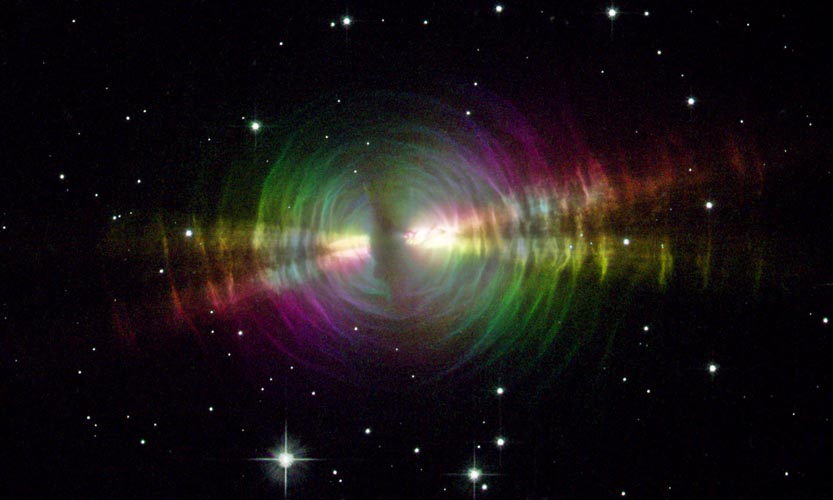
Description: Protoplanetary Nebula
Position: R.A. 21h 02m 18.80s Dec. +36° 41' 38".0
Constellation: Cygnus
Distance: About 3,000 light-years (about 1000 parsecs)
Dimensions: The image is 86 arcseconds (about 1 light-year or 0.4 parsec) wide.
Instrument: ACS/WFC
Exposure Date(s): September 27, 2002; October 16, 2002
Exposure Time: 1.5 hours
Filters: F606W (wide V) + polarization filters: POL0V, POL60V, POL120V
Image Credit: NASA and The Hubble Heritage Team (STScI/AURA)
Release Date: April 3, 2003
ABOUT THIS IMAGE:
Resembling a rippling
pool illuminated by underwater lights, the Egg Nebula offers astronomers
a special look at the normally
invisible dust shells swaddling an aging star. These dust layers, extending
over one-tenth of a light-year from the star, have an
onionskin structure that forms concentric rings around the star. A thicker
dust belt, running almost vertically through the image,
blocks off light from the central star. Twin beams of light radiate from
the hidden star and illuminate the pitch-black dust, like a
shining flashlight in a smoky room.
The artificial "Easter-Egg"
colors in this image are used to dissect how the light reflects off the
smoke-sized dust particles
and then heads toward Earth.
Dust in our atmosphere
reflects sunlight such that only light waves vibrating in a certain orientation
get reflected toward us.
This is also true for reflections off water or roadways. Polarizing sunglasses
take advantage of this effect to block out all
reflections, except those that align to the polarizing filter material.
It's a bit like sliding a sheet of paper under a door. The paper
must be parallel to the floor to pass under the door.
Hubble's Advanced
Camera for Surveys has polarizing filters that accept light that vibrates
at select angles. In this composite
image, the light from one of the polarizing filters has been colored red
and only admits light from about one-third of the nebula.
Another polarizing filter accepts light reflected from a different swath
of the nebula. This light is colored blue. Light from the final
third of the nebula is from a third polarizing filter and is colored green.
Some of the inner regions of the nebula appear whitish
because the dust is thicker and the light is scattered many times in random
directions before reaching us. (Likewise, polarizing
sunglasses are less effective if the sky is very dusty).
By studying polarized
light from the Egg Nebula, scientists can tell a lot about the physical
properties of the material responsible
for the scattering, as well as the precise location of the central (hidden)
star. The fine dust is largely carbon, manufactured by
nuclear fusion in the heart of the star and then ejected into space as
the star sheds material. Such dust grains are essential
ingredients for building dusty disks around future generations of young
stars, and possibly in the formation of planets around
those stars.
The Egg Nebula is
located 3,000 light-years away in the constellation Cygnus. This image
was taken with Hubble's Advanced
Camera for Surveys in September and October 2002.